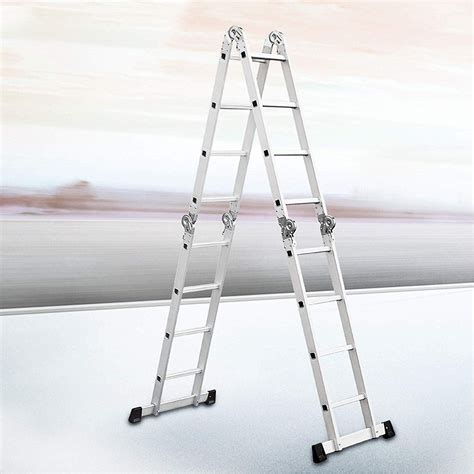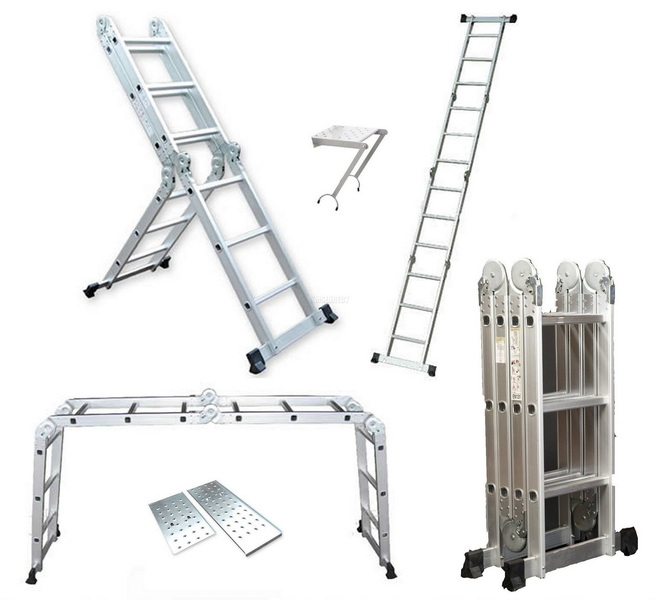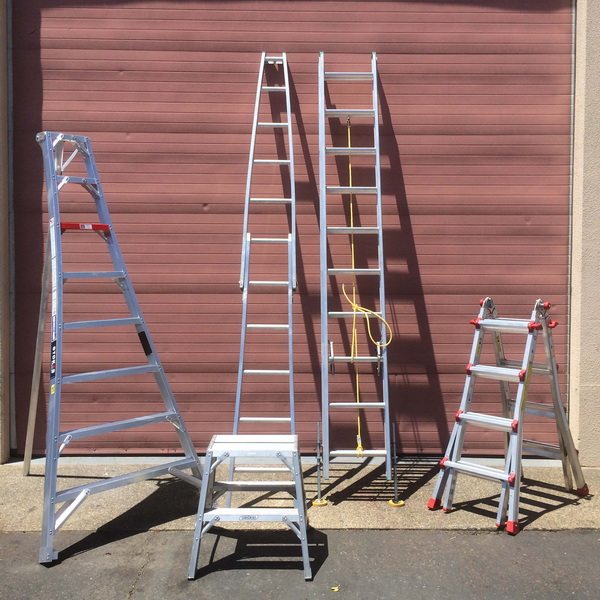Content Menu
● Understanding the Basics of Aluminum Scaffolding Ladders
>> Definition and Purpose
>> Key Features of Quality Aluminum Scaffolding Ladders
>> Types of Aluminum Scaffolding Ladders
● Primary Uses of Aluminum Scaffolding Ladders
>> Providing Access to Work Platforms
>> Facilitating Material Transport
>> Enabling Inspection and Maintenance
>> Serving as an Emergency Exit
● Benefits of Using Aluminum Scaffolding Ladders
>> Enhanced Safety
>> Increased Efficiency
>> Long-Term Durability
>> Improved Versatility
● Safety Considerations and Best Practices
>> Regular Ladder Inspections
>> Proper Ladder Placement and Securing
>> Maintaining Three Points of Contact
>> Adhering to Load Limits
>> Providing Comprehensive Training
● Relevant Regulations and Standards
>> OSHA (Occupational Safety and Health Administration)
>> ANSI (American National Standards Institute)
>> Local and State Regulations
● Materials and Construction of Aluminum Scaffolding Ladders
>> Aluminum Alloys Used
>> Manufacturing Processes
● Applications Across Various Industries
>> Construction Industry
>> Maintenance and Repair
>> Painting and Decorating
>> Electrical and HVAC Work
● Selecting the Right Aluminum Scaffolding Ladder
>> Height Considerations
>> Load Capacity Needs
>> Ladder Type
>> Code Compliance
● Conclusion
● FAQ
>> 1. What is the main purpose of an aluminum scaffolding ladder?
>> 2. What key safety features should I look for when choosing an aluminum scaffolding ladder?
>> 3. How often should aluminum scaffolding ladders be inspected?
>> 4. What are some common safety regulations for using aluminum scaffolding ladders?
>> 5. What are the benefits of using aluminum scaffolding ladders compared to other types of ladders?
● Citations:
An aluminum scaffolding ladder is a crucial component of any scaffolding system, providing safe and efficient access to elevated work platforms. Unlike traditional ladders, aluminum scaffolding ladders are specifically designed to integrate seamlessly with scaffolding structures, offering enhanced stability and security for workers. They are essential for various construction, maintenance, and repair tasks. This article explores the many uses of an aluminum scaffolding ladder, along with the key features, safety considerations, and benefits that make it an indispensable part of modern construction sites. We will also discuss different types of scaffolding ladders and best practices for ensuring worker safety.

Understanding the Basics of Aluminum Scaffolding Ladders
Definition and Purpose
An aluminum scaffolding ladder is a specialized ladder engineered for use within a scaffolding system. Its primary function is to provide a secure and reliable means of ascending and descending to and from the scaffolding platform. These ladders are made from lightweight yet durable aluminum alloys.
Key Features of Quality Aluminum Scaffolding Ladders
Referencing the attached file, when evaluating aluminum scaffolding ladders, these features are paramount:
- Material Quality: High-strength aluminum alloy construction, resistant to corrosion and bending.
- Anti-Slip Rungs: Essential for maintaining a firm grip and preventing slips.
- Secure Attachment: Reliable mechanisms for attaching the ladder to the scaffold frame.
- Compliance: Adherence to OSHA/ANSI safety standards.
Types of Aluminum Scaffolding Ladders
Various aluminum scaffolding ladders cater to different scaffolding configurations:
- Frame Ladders: Integrated directly into the scaffolding end frame.
- Hook-On Ladders: Attached using hooks, allowing for flexible positioning.
- Swing Gate Ladders: Feature a swing gate for platform access/egress.
- Step Ladders/Podium Ladders: Shorter ladders for reaching lower platform heights.
Primary Uses of Aluminum Scaffolding Ladders
Providing Access to Work Platforms
The fundamental use of an aluminum scaffolding ladder is providing safe and convenient access to the elevated work platform. This allows workers to perform tasks at height, such as:
- Painting and finishing
- Masonry and bricklaying
- Electrical work
- HVAC installation and repair
- Siding and exterior work
Facilitating Material Transport
Aluminum scaffolding ladders can assist in transporting tools and materials to the platform, although safety precautions are necessary. Distribute the load evenly and never exceed the ladder's weight capacity. Consider using a rope and pulley system for heavier items.
Enabling Inspection and Maintenance
Ladders provide access for inspecting the scaffolding itself, ensuring all components are in good condition. Regular inspections are essential for maintaining a safe working environment. Maintenance may involve tightening bolts, replacing damaged parts, or adjusting the scaffolding's configuration.
Serving as an Emergency Exit
In an emergency, the aluminum scaffolding ladder serves as a means of rapid egress from the work platform. Workers should be trained on emergency procedures, including the ladder's location and safe usage.
Benefits of Using Aluminum Scaffolding Ladders
Enhanced Safety
The primary benefit of using aluminum scaffolding ladders is the improved safety they offer. Anti-slip rungs, secure attachments, and robust construction minimize the risk of falls and injuries.
Increased Efficiency
Lightweight aluminum allows for easy maneuverability and quicker setup times. This allows workers to spend more time on the task at hand and less time on accessing the platform.
Long-Term Durability
Aluminum's natural corrosion resistance ensures a long service life, even in harsh outdoor environments. This makes aluminum scaffolding ladders a cost-effective investment.
Improved Versatility
Different types of aluminum scaffolding ladders cater to varied scaffolding configurations, making them suitable for diverse projects and work sites.

Safety Considerations and Best Practices
Safety must be the paramount concern when working with aluminum scaffolding ladders.
Regular Ladder Inspections
- Check for bent or broken rungs.
- Ensure all welds and connections are secure.
- Verify the anti-slip surface is intact.
- Confirm proper attachment mechanisms are functioning.
- Remove any ladder failing inspection from service immediately.
Proper Ladder Placement and Securing
- Place the ladder on a level, stable base.
- Securely attach the ladder to the scaffold frame using appropriate hardware.
- Ensure the ladder extends at least 3 feet (0.9 meters) above the platform.
Maintaining Three Points of Contact
Workers must always maintain three points of contact (two hands and one foot, or two feet and one hand) while climbing or descending.
Adhering to Load Limits
Never exceed the ladder's maximum load capacity. Post the load limit clearly on the ladder itself.
Providing Comprehensive Training
- Proper inspection procedures.
- Safe climbing techniques.
- Load limit awareness.
- Emergency egress procedures.
Relevant Regulations and Standards
OSHA (Occupational Safety and Health Administration)
OSHA provides comprehensive regulations regarding scaffolding and ladder safety, including requirements for ladder construction, inspection, and usage.
ANSI (American National Standards Institute)
ANSI establishes standards for ladder safety, offering detailed specifications for design and performance.
Local and State Regulations
Always verify local and state regulations, which may be more stringent than federal guidelines.
Materials and Construction of Aluminum Scaffolding Ladders
Aluminum Alloys Used
Commonly used alloys include 6061-T6 and 6063-T5 aluminum, known for their strength, corrosion resistance, and weldability.
Manufacturing Processes
Extrusion, welding, and assembly are the typical manufacturing steps. Quality control is crucial at each stage to ensure the ladder meets all safety requirements.
Applications Across Various Industries
Construction Industry
Aluminum scaffolding ladders are indispensable for a wide array of construction tasks, providing access for:
- Framing
- Siding installation
- Roofing work
- Painting and finishing
- Masonry
Maintenance and Repair
Ladders facilitate maintenance and repair work in commercial, industrial, and residential settings.
Painting and Decorating
Painters rely on ladders to access walls, ceilings, and other surfaces.
Electrical and HVAC Work
Electricians and HVAC technicians use ladders to reach equipment and wiring at height.
Selecting the Right Aluminum Scaffolding Ladder
Height Considerations
Select a ladder that extends high enough for comfortable and safe access.
Load Capacity Needs
Ensure the ladder can support the worker's weight plus any tools or materials.
Ladder Type
Choose the appropriate ladder type for your scaffolding configuration and specific application.
Code Compliance
Verify that the ladder meets all applicable safety codes and regulations.
Conclusion
An aluminum scaffolding ladder is much more than just a means of access; it's an integral component of a safe and efficient scaffolding system. By understanding the uses, benefits, safety practices, and regulations associated with these ladders, construction professionals can create a safer and more productive work environment. Prioritizing quality, regular inspections, and proper training ensures that workers can confidently rely on aluminum scaffolding ladders for their daily tasks.

FAQ
1. What is the main purpose of an aluminum scaffolding ladder?
The primary purpose is to provide safe and reliable access to elevated work platforms on scaffolding systems.
2. What key safety features should I look for when choosing an aluminum scaffolding ladder?
Look for anti-slip rungs, secure attachment mechanisms, robust aluminum construction, and compliance with safety standards.
3. How often should aluminum scaffolding ladders be inspected?
Aluminum scaffolding ladders should be inspected before each use for any signs of damage or wear.
4. What are some common safety regulations for using aluminum scaffolding ladders?
Common regulations include following OSHA and ANSI guidelines, maintaining three points of contact, and adhering to load limits.
5. What are the benefits of using aluminum scaffolding ladders compared to other types of ladders?
Aluminum ladders are lightweight, durable, corrosion-resistant, and designed for seamless integration with scaffolding systems, improving safety and efficiency.
Citations:
[1] https://msafegroup.com/what-are-the-benefits-of-aluminum-scaffolding/
[2] https://www.tp-scaffold.com/what-is-an-aluminum-scaffolding-ladder-used-for.html
[3] https://fmafactory.com/blog/why-is-aluminum-used-for-scaffolding-what-are-the-general-guide-for-scaffolds/
[4] https://www.ekscaffolding.com/aluminum-scaffolding-ladder-supplier.html
[5] https://industrialladder.com/scaffolding/aluminum-scaffold/
[6] https://www.istockphoto.com/photos/aluminum-ladders






















